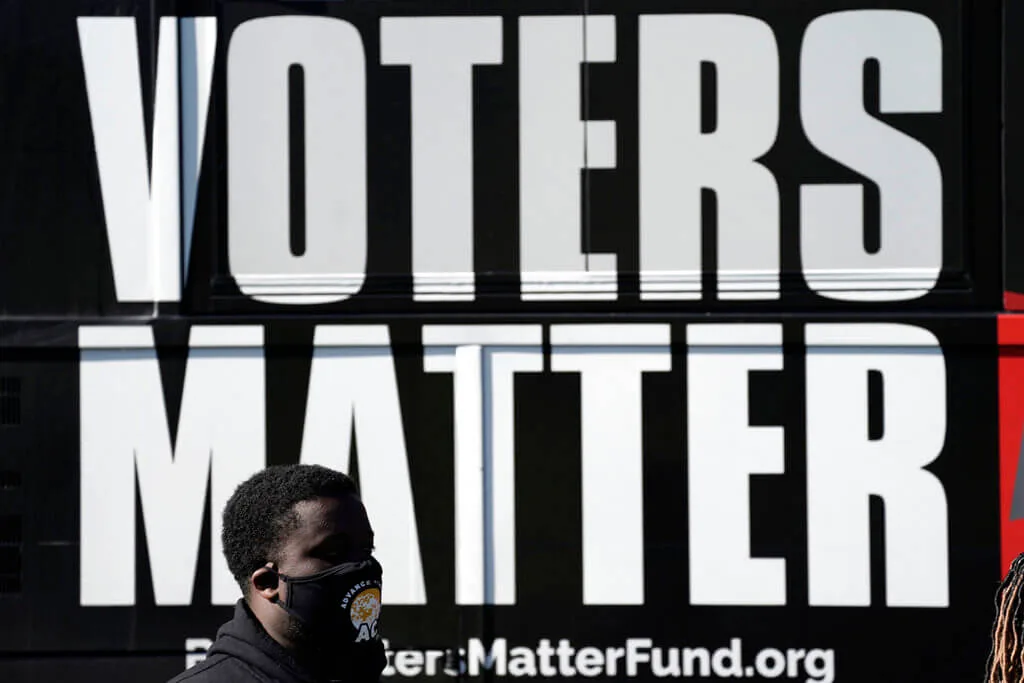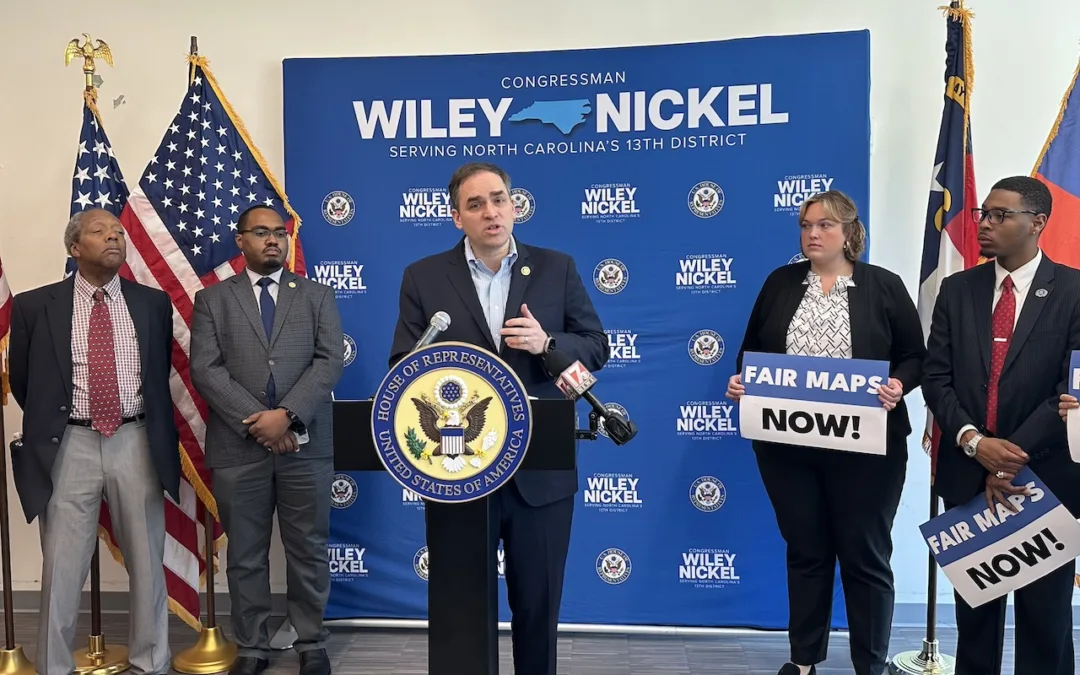
In this Nov. 3, 2020, photo, a man wearing a mask gathers with a group in support of Black Voters Matter at the Graham Civic Center polling site in Graham. (AP Photo/Gerry Broome)
The ruling means the Republican-led legislature will need to create more even-handed maps for the upcoming 2022 Congressional and state legislative elections.
North Carolina’s new election maps, which were intentionally drawn by the Republican legislature to give them an outsized advantage, are unconstitutional, the North Carolina Supreme Court has ruled.
The court’s decision, which was delivered late Friday afternoon, instructed the General Assembly to redraw the maps by Feb. 18.
“When a districting plan systematically makes it harder for one group of voters to elect a governing majority than another group of voters of equal size, the General Assembly unconstitutionally infringe upon that voter’s fundamental right to vote,” the justices wrote in the 4-3 opinion.
The maps, the court ruled, violated the free election, equal protection, free speech and freedom of assembly clauses of the North Carolina state constitution.
Several groups, including the NC chapter of the NAACP and Common Cause NC, filed lawsuits in the fall after the maps in question were enacted. The maps would have given Republican candidates an uncontested path to 10 of North Carolina’s 14 Congressional House seats in a state that is largely split down the middle. North Carolinians, for instance, have elected a Democratic governor two terms in a row, and voted for Donald Trump over Joe Biden by a small margin.
The new maps would have ignored these evenly split demographics and in creating them Republican lawmakers intentionally targeted voters of color, voting rights groups and independent analyses said in their arguments before the court.
The initial maps drawn by Republican lawmakers also intentionally split areas with large number of Black voters across several districts, voting rights groups said.
This was blatant partisan and racial gerrymandering, voting rights groups said, and the maps were unconstitutional and should be thrown out.
The new maps, according to an analysis by the News and Observer, puts one in four Black lawmakers in the state at risk of losing their seats, simply because the maps shifted them into heavily white and conservative districts. There are nearly 1.5 million Black registered voters in North Carolina, according to state election data. There are 12 Black state senators, 24 Black members of the NC House, and two Black members of US Congress. North Carolina has never elected a Black senator, though that could change in 2022 if voters back the likely Democratic candidate Cheri Beasley.
Behind the Lawsuit
Several groups, including the NC chapter of the NAACP and Common Cause NC, filed lawsuits in the fall after the maps were enacted. The maps would give Republican candidates an uncontested path to 10 of North Carolina’s 14 Congressional House seats.
In arguments before the court on Wednesday, lawyers for the plaintiffs, which included the NC chapter of the NAACP and Common Cause NC, said that the Republican legislature had intentionally gotten in the way of voters’ ability to choose their own representatives.
“Every voter gets an equal say in who will represent their interests, and the will of the people as a whole determines which party controls the levers of power,” R. Stanton Jones, a lawyer representing Rebecca Hall, a member of Common Cause NC said in his opening statement. But, “in a partisan gerrymander the leaders already in power manipulate the district lines to subvert the will of the people.”
Much of the back and forth in court hinged on the meaning of a few words – what’s an okay level of partisanship and what’s extreme; what “the will of the people” really means; and whether a state requirement for “free elections” meant those elections have to be fair, too.
The state constitution prohibits only “extreme” gerrymandering, and so, lawyers for the Republican lawmakers argued, some partisan intent is allowed and is perfectly legal.
The law is quiet, however, on what specifically defines what’s acceptable and what’s “extreme.” For the court to rule that these maps crossed the line, Phil Strach, a lawyer for the lawmakers, said, it would first have to define that line, something other appellate courts have declined to do.
It falls to the legislature to specify those terms, Strach said, and not the courts. For the courts to make such a ruling, he said, would amount to “legislating from the bench.”
Lawyers for the plaintiffs rejected any arguments that the state’s highest court had no authority to intervene. If no one can define “extreme gerrymandering” then the law against it is meaningless.
“This court really is the only check here,” Zack Schauf, an attorney for the plaintiffs, said. “Elections can’t provide a check. The governor can’t provide a check. Amendments aren’t available. And it will only get worse if this court gives the General Assembly a blank check.
The justices addressed that point in their decision.
While the General Assembly had the “duty” to draw the legislative and congressional maps, the court ruled, “exercise of this power is subject to limitations imposed by other constitutional provisions.”
In matters violating the constitution’s Declaration of Rights, they ruled, the court had final authority.
Politics

Op-ed: Why we need to ban partisan gerrymandering once and for all
Some legislatures draw election maps that empower their favored voters and disenfranchise those on the other side. The “Fair Maps Act,” Congressman...

VIDEO: This Woman’s Devastating Story Shows the Consequences of Overturning Roe v. Wade
View this post on Instagram A post shared by Cardinal & Pine (@cardinalandpine) Amanda Zurawski and her husband Josh had tried for...
Local News

The 5 most believable UFO sightings ever reported in North Carolina
Read about five alien encounters that may forever remain unexplained. When you think of the most common places where you might hear a UFO sighting...

Good News Friday: It’s a good day to be a fan of the NC State Wolfpack
The men's and women's teams will compete for a national championship in college basketball this weekend. Plus: How to watch the solar eclipse, and...





